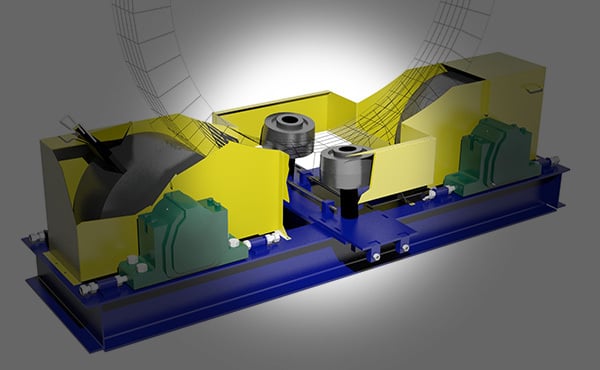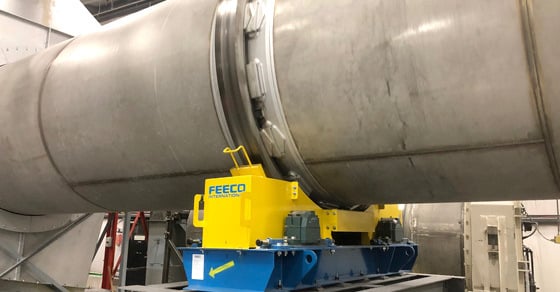An adequate preventative maintenance plan is a major contributing factor to maximizing the service life of a rotary drum, be it a dryer, cooler, kiln, or granulator.
Despite being a rugged piece of equipment, rotary drums require a careful balance of load on mechanical components in order to maintain mechanical stability and minimize wear.
One essential tool in any rotary drum maintenance program is maintaining proper drum float through a practice known as drum training; training the drum after installation and routinely throughout the equipment’s life will minimize wear on load-bearing components and help prevent unnecessary damage to the unit.
What is Drum Training
Training is closely related to rotary drum alignment, but instead of focusing on trunnion wheel positioning and alignment, centers around achieving the proper positioning of the drum between thrust rollers. This aspect of positioning is known as drum float, as the goal is to get the drum to “float” properly between thrust rollers without riding too hard on the uphill or downhill thrust roller.
Thrust rollers are positioned on both sides of the tire at each pier, ensuring that the drum cannot drift longitudinally in either direction.
A drum riding too hard against any thrust roller is not only a sign that the drum is not floating properly, but may also indicate that the drum has fallen out of alignment and may require drum realignment by a professional.

3D Rendering showing how thrust rollers rest on both sides of the tire to prevent the drum from drifting longitudinally
Why Drum Training is Important
Along with alignment, achieving the proper drum float is a key aspect of the drum’s mechanical stability. If a drum is not properly floating between thrust rollers, it is subsequently pushing too hard uphill or downhill. And while very slight thrust roller contact is permissible, anything more has the potential to cause significant wear on both the tire and the thrust roller, as it puts the tire in high-pressure contact with the thrust roller.
In addition to damaging the tire and thrust roller, improper float also impacts the mechanical stability of the unit, which is critical to the overall longevity of the drum and its many components; problems that start in the base have a compounding effect on all components, escalating over time as the drum becomes more and more out of balance, putting undue strain on all components.
When to Conduct Drum Training
Drums are trained after initial installation of the unit as part of the start-up process. After that, drums require routine training as they experience normal wear and tear, which causes the drum to fall out of proper float over time.
How Often Should Rotary Drums Be Trained?
There is no set frequency for drum training, as each installation has its own unique demands. Training should be conducted as needed as part of a preventative maintenance plan. Operators and maintenance personnel should check drum float during routine inspections and should be trained in recognizing when training is necessary. In general, the greater the drum slope, the more often training will be required.
Recognizing the Need for Drum Training
Since the rotary drum is in motion on a slope, it will always be in a constant state of falling out of proper float. As such, operators can assume that the drum will need to be trained regularly. Drum training should be carried out before any visible signs of wear or damage occur, as these indicate the drum has been out of float for too long.
Additionally, any major repairs to the drum (ex., gear replacement) are likely to throw the drum out of alignment and float, requiring realignment and training after repairs are complete.
How Drum Training Works
While training a drum is a relatively simple procedure, it is one of the most commonly neglected and improperly conducted aspects of rotary drum maintenance. It also has the potential to cause significant damage if not conducted properly, with impacts on tires, trunnions, thrust rollers, gears, drive components, refractory (where applicable), breechings, and the drum shell itself.
Training is carried out by adjusting or skewing the trunnion bearings to influence the amount and direction of longitudinal thrust the drum is experiencing. The trunnion bearings are moved in very small increments, on the order of 0.001” to 0.010”.
Maintenance personnel should take care in not adjusting the bearings too much, too little, or unevenly, as all can result in extensive damage. For the same reason, FEECO recommends double and triple checking the direction of bearing movement prior to making any actual adjustments, as moving the bearing in the wrong direction can have severe consequences. It’s also important to recognize that the need for excessive adjustment could be an indication that the trunnion bases were not installed correctly and may require repair.
Any adjustments made should be accurately measured and recorded.
Drum Training Tips & Considerations
The following information provides guidance on properly training a drum for adequate float.
Disclaimer: While the text below provides some general guidance on drum training, it is not a comprehensive guide and is not meant to serve as sole guidance on drum training. Always consult your original equipment manufacturer for proper maintenance and safety procedures before making any adjustments. FEECO does not make any representations or warranties (implied or otherwise) regarding the accuracy and completeness of this guide and shall in no event be held liable for any loss of profit or any commercial damage, including but not limited to special, incidental, consequential, or other damage.
Cold Training vs. Hot Training
Drum float will change depending on the load of the drum. In other words, an empty drum will float differently than a drum with a full load. For this reason, drums are often trained “cold” and “hot” to achieve the best result.
Cold training refers to training the drum while it is empty, and if applicable, not heated. Hot training refers to training the drum under production load, and if applicable, while heated, as in the case of rotary dryers and kilns.
Drum Training Tips
Consider Accessibility
When initially training the drum after installation, it may be desirable to favor the most accessible thrust roller to improve ease of training and thrust roller replacement in the future.
Make Small Adjustments and Allow Time in Between
Over-adjusting the trunnions is tempting in an effort to make the training process go as quickly as possible. However, this risks running the drum too far in the opposite direction, a larger problem. As such, only small incremental adjustments should be made in order to avoid over adjustment.
Because it can take up to several days to see the full effect of an adjustment, allow ample time between adjustments. The amount of time it takes to see the results of an adjustment differs in each setting, but as a general rule, the longer the time between adjustments, the better.
Take Advantage of Dial Indicators
Always use dial indicators; sometimes tightening or loosening bearing bolts can cause very slight movements in the bearings which need to be accounted for. Dials will help to identify these movements and should be kept in place for the entire duration of the adjustment process.
Always Record Adjustments
Be prepared to make recording adjustments as simple as possible. It is easy to forget what adjustments were made and accidentally end up over adjusting the unit.
Check, Check, and Check Again
As mentioned, it is best practice to double and even triple check the direction of bearing movement prior to making any actual adjustments, as moving the bearings in the wrong direction can throw the whole drum out of alignment, requiring realignment of the unit.
Pull Bearings Outwards
When “pulling” a bearing outwards, it is important to pull the bearing out past the intended adjustment and then “push” it back to the desired number. This ensures that any “slop” in the threads of the jacking bolt or bearing housing is taken up.
Conclusion
Achieving the proper drum “float” between thrust rollers through routine training is a critical aspect of maintaining mechanical stability and maximizing the life of any type of rotary drum and should be included as part of a preventative maintenance program. Ensure that training is conducted with care by not over-adjusting the unit, allowing time between adjustments, using dial indicators, and recording measurements.
Those struggling with drum training or alignment issues should contact the FEECO Customer Service Team, which provides a range of services, including equipment audits and inspections, laser alignments, drum training, and more.


